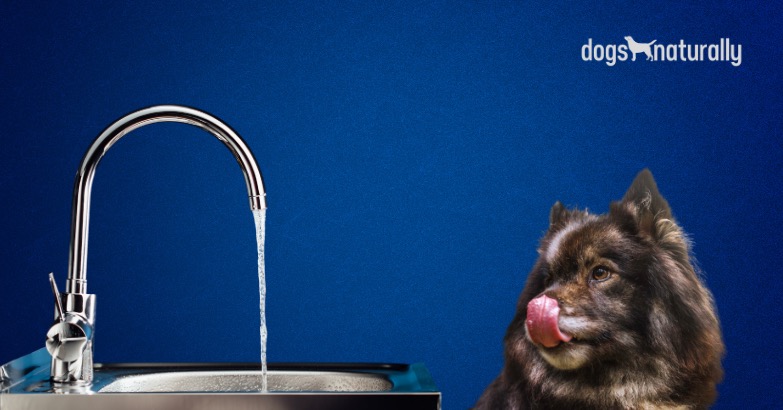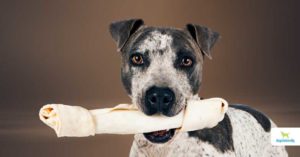If your dog drinks tap water, you need to know the answer to this question …
Can Dogs Have Fluoride?
The answer is no … dogs shouldn’t have fluoride. Fluoride affects brain development, bone strength and may disrupt hormones. And that means, in most places, your dog shouldn’t drink tap water … or eat processed dog food. Fluoride won’t improve his teeth either.
Fluoride Is A Neurotoxin
If you want to know the answer to the question, is fluoride bad for dogs? … there’s a 2014 research study published in one of the world’s most distinguished medical journals, The Lancet, that classified fluoride as a dangerous neurotoxin (1). The same study placed fluoride in the same category as other known toxins, like arsenic, lead and mercury.
The study showed that children exposed to fluoride in drinking water at levels of less than 4 milligrams per liter (the allowed level in US water), found an average 7 point decrease in the IQs of these children (2).
Just 7 points may not seem like much. But it’s enough to make the researchers worried that fluoride could be causing neurodevelopment disabilities. These include conditions like ADHD, dyslexia and other cognitive disorders, which affect millions of children.
The report highlights “very great concern that children worldwide are being exposed to unrecognized toxic chemicals that are silently eroding intelligence.” The researchers were so worried about these dangers that they called for “all chemicals in existing use and all new chemicals” to be tested for developmental toxicity.
The EPA also warns that “adults exposed to excessive consumption of fluoride over a lifetime may have increased likelihood of bone fractures, and may result in effects on bone leading to pain and tenderness.”
If fluoride causes cognitive issues in children and bone weakness in adults, it almost certainly does in dogs too. In fact, it’s likely dogs suffer even more ill effects from fluoride than people do, and not just neurological development issues. And the worst part is … fluoride is very hard to avoid.
Fluoride Toxicity In Dogs
There are two major ways that fluoride gets into your dog.
#! Fluoride In Your Dog’s Water
Fluoride is added to many city water supplies to help prevent tooth decay.
Legal Limits On Fluoride In the US
In 2015, the US Public Health Services formalized its recommendation for an an optimal fluoride concentration of 0.7 milligrams/liter. But this is a recommendation, not an enforceable regulation. The PHS says this level provides enough fluoride to prevent tooth decay in children and adults while limiting the risk of dental fluorosis (which they claim is “the only unwanted health effect of community water fluoridation”) (3)
Since January 2011, the EPA’s maximum allowed level of fluoride in US public water systems is 4.0 mg/L. The US EPA has a secondary non-enforceable standard of 2.0 mg/L, to protect children against the dental fluorosis – the tooth discoloration and/or pitting that can be caused by excess fluoride exposures during the formative period before adult teeth appear. This means public water authorites must notify the public if the levels exceed the secondary standard.
Some private well water may even contain fluoride as it’s naturally present in most water. Bottled water is also allowed to contain fluoride, and is currently limited to 0.7 mg per liter. But there’s no requirement to disclose this on the label, so you have to contact the manufacturer to find out.
Fluoride In Canadian Water
In Canada, the limit for fluoride in drinking water is a Maximum Acceptable Concentration of 1.5 mg/L. The government reports that in 2005 community fluoridated drinking water was supplied to 43% of Canadians. Fluoride is also found in some groundwater sources. Municipalities can use various techniques to lower the levels of fluoride. With private water supply, they advice homeowners to use reverse osmosis or distillation systems.
Other Countries
Most European countries have stopped adding fluoride to drinking water because of its toxic properties. As of May 2019, 97% of the Western European population has non-fluoridated water.
In some countries like China, India and parts of Africa, the water has high natural fluoride levels. In these countries, they’re removing the fluoride from the water supply.
But in the US, fluoride is still added to drinking water … it’s estimated that 3 in 4 Americans are drinking fluoridated water… which probably means 3 in 4 dogs are drinking fluoride too.
Not only that, but it’s absorbed through the skin as well, so every time you bathe your dog or let him swim in your pool, he’s likely being exposed to unsafe levels of neurotoxic fluoride. And there are other ways your dog is getting too much fluoride …
#2 Fluoride In Dog Food
Because fluoride is added to drinking water, it infiltrates everything. Plants, processed foods and feed animals all accumulate fluoride until the safe levels in the drinking water are blown away. This is especially true for kibble and processed foods.
Independent studies, including those done by the Environmental Working Group (EWG), show that many processed dog foods have excessive levels of fluoride that are as much as 2.5 times higher than “safe” levels. The EWG’s report notes fluoride’s link to neurotoxicity, hormonal disruption and bone cancer. They conclude,
“This high level of fluoride exposure may well be a contributing factor to osteosarcoma in dogs.
Most of the fluoride in pet food comes from …
- Chicken byproduct meal
- Poultry byproduct meal
- Meat meal
- Meat and bone meal
- Animal digest
- Chicken meal
If you feed a commercial dog food, check the labels for these ingredients and avoid them. But keep in mind fluoridated water is also added to the food during processing.
If you brush your dog’s teeth, you’ll also want to check his toothpaste ingredients to make sure there’s no fluoride; it’s present in some pet toothpaste brands. Here’s some information about natural toothpaste and DIY options for dogs. (You may want to check out the warning labels on your own toothpaste too.)
Risks Of Fluoride Toxicity
One of the main risks of too much fluoride is a disease called skeletal fluorosis.
Skeletal fluorosis is a painful, debilitating disease caused by a buildup of fluoride in the body. This disease is often misdiagnosed, even in later stages of the disease, as the symptoms mimic those of other diseases.
Since fluoride’s effects are cumulative, it’s easy to mistake fluorosis for arthritis symptoms. Xrays only show the more advanced stages of the disease and completely miss the early stages. Early stage symptoms of fluorosis include stiffness and painful joints and may just be dismissed as your dog’s normal aging process or a bit of arthritis.
More advanced stages of the disease can also be misdiagnosed as conditions like spondylosis or renal osteodystrophy (abnormal bone growth the results from kidney disease).
It’s widely thought that skeletal fluorosis is not an issue in North America … but in reality, early onset is possibly rampant and either misdiagnosed or missed completely.
Other Fluoride Risks
New studies have ironically linked dental disease to fluoride. So the substance that’s intended to prevent tooth decay is damaging teeth in other ways.
Fluoride can also cause …
- Weakening of bones
- Bone loss
- Bone cancer (especially osteosarcoma)
And research also shows that fluoride can affect kidney and endocrine health.
- Kidney disease (4)
- Hypothyroidism (5, 6, 7)
Gastrointestinal upset has also been linked to fluoride.
It’s possible that fluoride increases your dog’s risk of getting osteosarcoma. Several studies have found that boys who drink fluoridated tap water between the ages of six and eight have an increased risk of osteosarcoma, and dogs may be even more susceptible to this deadly disease.
Consider the numbers: more than 10,000 osteosarcoma cases occur in US dogs each year (and this number may be understated as not all cases are confirmed and registered). This is over 10 times higher than osteosarcoma cases in the US human population, which are less than 1,000 a year.
Why is it so much higher in dogs? Could it be because they’re consuming a lot of extra fluoride through their food — and eating the same food every single day, compared to humans who eat a much wider variety of foods? The damage from excessive fluoride is cumulative and for the most part, irreversible.
Avoid Fluoride For Dogs
While some symptoms can be treated, the safest approach is to make sure your dog gets as little fluoride as possible.
- Don’t feed processed foods like kibble or canned foods, and if you do, make sure they don’t contain ingredients like chicken byproduct meal, chicken meal or other meat meals, animal digest, and bone meal.
- If you feed your dog a raw diet, buy the best ingredients you can afford. Try to get pastured, free-range (non-factory-farmed) meats, and buy organic veggies and fruits.
- Find out whether your municipal water or your well water contains fluoride. If it does, give your dog filtered drinking water, and make sure the filter you buy does filter out fluoride, as many (including Brita brand filters) don’t. Most reverse osmosis filters are effective against fluoride.
- Some bottled water may also contain fluoride, but the FDA doesn’t require companies to disclose it on the label. So the only way to find out is to contact the manufacturer.
How To Detox Fluoride From Your Dog
Here are some ways to help remove fluoride from your dog’s body.
Feed Kelp
Iodine can help detoxify fluoride accumulation, so adding kelp to your dog’s diet is a good idea. Make sure you buy kelp from a reputable manufacturer who tests their kelp for purity. Kelp sourced from Nova Scotia, Iceland and New Zealand is generally considered best because those waters are less polluted.
Give about ¼ tsp per 10 lbs of body weight per day.
Give Chlorella
Chlorella is known for its ability to bind toxins and help remove them from the body.
Start out slowly and build up to 1 gram of chlorella daily for small dogs and up to 3 grams for larger dogs.
Other herbs said to help remove fluoride from the body include …
- Turmeric/curcumin
- Cayenne (not too much – it’s very spicy)
- Parsley
- Cilantro
Even though fluoride is nearly impossible to avoid, these foods may help detoxify your dog and keep him safe from fluoride-related diseases.
References
- Dr Philippe Grandjean MD, Philip J Landrigan MD. Neurobehavioural effects of developmental toxicity. The Lancet (Neurology), Review Vol 13, Issue 3, March 1, 2014.
- Choi AL, Sun G, Zhang Y, Grandjean P. Developmental fluoride neurotoxicity: a systematic review and meta-analysis. Environ Health Perspect. 2012 Oct;120(10):1362-8. doi: 10.1289/ehp.1104912. Epub 2012 Jul 20.
- U.S. Department of Health and Human Services Federal Panel on Community Water Fluoridation. U.S. Public Health Service Recommendation for Fluoride Concentration in Drinking Water for the Prevention of Dental Caries. Public Health Rep. 2015;130(4):318-331.
- Dharmaratne RW. Exploring the role of excess fluoride in chronic kidney disease: A review. Hum Exp Toxicol. 2019 Mar;38(3):269-279.
- Marta Skórka-Majewicz, Marta Goschorska et al. Effect of fluoride on endocrine tissues and their secretory functions — review. Chemosphere, Volume 260, 2020.
- Kheradpisheh Z, Mirzaei M, et al. Impact of Drinking Water Fluoride on Human Thyroid Hormones: A Case- Control Study. Sci Rep. 2018 Feb 8;8(1):2674.
- Błażewicz A, Wiśniewska P, Skórzyńska-Dziduszko K. Selected Essential and Toxic Chemical Elements in Hypothyroidism-A Literature Review (2001-2021). Int J Mol Sci. 2021 Sep 20;22(18):10147.












